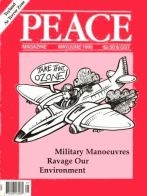
Peace Magazine May-Jun 1992, page 4. Some rights reserved.
Search for other articles by Metta Spencer here
COMPARE the contents of this issue with any PEACE Magazine published during our first year, 1985. You will find that some of the problems we cover today existed then; examples include the long-standing conflict between India and the Muslim nationalists in Kashmir, and Canada's chummy relationship with Indonesia, a nation that grossly violates human rights. However, we didn't cover such stories in the days when the nuclear arms race commanded our entire attention.
But as this issue shows, peace workers and researchers are now more diverse in our ways of working:
Some of us are involved in protecting the planet's environment today especially by exposing the impact of militarism. (See Kristen Ostling's astonishing findings, part of a major research project organized by Science for Peace as a contribution to the U.N. "Earth Summit" coming up in Brazil in June.) This work is especially important, considering the obstacles set up by the Bush Administration, which has managed to keep militarism off the summit's agenda. To everyone's disappointment, the U.N. preparatory committee was unable to reach agreement on a document to be introduced at the Brazil conference, which means that agreement may be unattainable during that session.
Some of us are training for nonviolent actions in hot spots around the world, as well as at home. (See Janey Skinner's description of her 'spring training.")
Some of us work in peace education with children. (See Rose Dyson's indictment of the toy and entertainment business, and Jerry Diakiw's reviews of peaceable children's reading for the summer.)
Some of us work by opposing the glorification of such "war heroes" as "Bomber Harris" and the Bush Administration-those responsible for atrocities against civilians in previous wars. (See Gil Kezwer's piece on memorializing the man behind the firebombing of Dresden. And see Subha Xavier's coverage in Newsworthy of Ramsey Clark's tribunal on war crimes perpetrated in the Gulf War.)
Some of us analyze the twists and turns that have taken place in the former superpower, the Soviet Union. (See Carl Jacobsen's review of its history in recent years and now the rivalries among its successor states. Also, see Rob Prince's expose of the finances behind the World Peace Council, the old Soviet-sponsored peace organization that remains alive despite the collapse of the nation that it served. This story is still breaking. In our next issue, Prince expects to provide even more details about the byzantine financial arrangements of this organization.
Some of us are engaged creating new structures to support civil society in the "Helsinki area"-approximately the top one-third of our planet. (See our coverage of the Helsinki Citizens Assembly meeting in Bratislava.)

Peace Magazine May-Jun 1992, page 4. Some rights reserved.
Search for other articles by Metta Spencer here